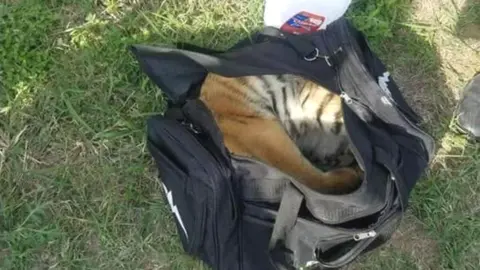Tiger cub abandoned in duffel bag at US-Mexico border
 US Customs and Border Protection
US Customs and Border ProtectionUS border patrol agents found a tiger cub in a bag abandoned by individuals trying to illegally enter the country at the Texas border, officials say.
The male tiger cub was unconscious inside a black duffel bag, according to a statement from the US Customs and Border Protection.
When the individuals realised agents were nearby, they fled back to Mexico, leaving the cub behind in their escape.
The cub, only several months old, is now in the care of a local zoo.
Brownsville, Texas border officials had been ready to intercept the group, but discovered the young tiger instead.
"Not an average day in the field," tweeted Irma Chapa, communications director for Rio Grande Valley border patrol.
Allow X content?

The cub is currently at Gladys Porter Zoo in Brownsville, CBS News reports. The zoo specialises in handling endangered animals.
Ms Chapa later tweeted that the rescued cub, now appearing awake and alert, is expected to make a full recovery.
Allow X content?

The cub is one of many exotic animals smugglers attempt to sneak across the US-Mexico border.
It has become quite a lucrative industry in Mexico, and drug traffickers often keep imported animals on their ranches.
Earlier this year, a US teenager was sentenced to six months in prison for trying to smuggle a six-week-old Bengal tiger cub from Mexico.
The US has one of the world's highest demands for trafficked wildlife, according to a 2015 report by US-based conservation group Defenders of Wildlife.
Around the world, the illegal animal industry generates between $7bn (£5bn ) and $23bn (£17bn ) the report states.
Defenders of Wildlife senior international counsel Alejandra Goyenecha told the Washington Post that a quarter of the 50,000 animals seized in the US between 2005 and 2014 came from Latin America.
 US Customs and Border Protection
US Customs and Border ProtectionSmugglers typically use the same US-Mexico routes as drug, weapon and human traffickers, Ms Goyenecha said.
Many animals are transported in containers or luggage, like the tiger cub discovered on Tuesday.
And many, according to Ms Goyenecha, do not survive the journey across the border, dying from suffocation or hunger.
In 2014, the World Wildlife Fund reported that there were more tigers in captivity in the US than in the wild.
During the Obama administration, the US announced a national strategy for combating wildlife trafficking in an effort to reduce demand for illegal wildlife in the US and abroad.
